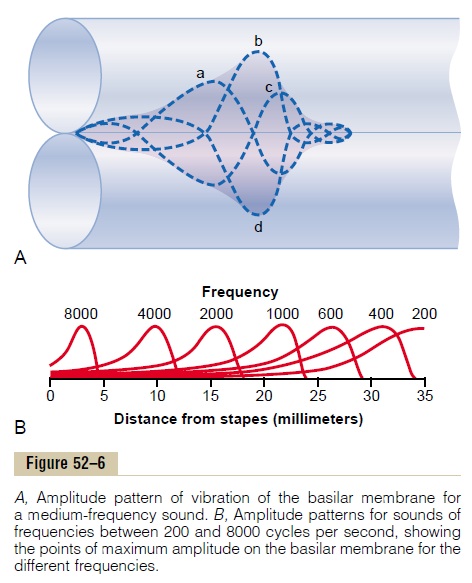Chapter: Medical Physiology: The Sense of Hearing
Determination of Sound Frequency- The ÔÇťPlaceÔÇŁ Principle - Cochlea
Determination of Sound Frequency- The ÔÇťPlaceÔÇŁ Principle
From earlier discussions, it is apparent that low-frequency sounds cause maximal activation of the basilar membrane near the apex of the cochlea, and high-frequency sounds activate the basilar mem-brane near the base of the cochlea. Intermediate-frequency sounds activate the membrane at inter-mediate distances between the two extremes.
Furthermore, there is spatial organization of the nerve fibers in the cochlear pathway, all the way from the cochlea to the cerebral cortex. Recording of signals in the auditory tracts of the brain stem and in the audi-tory receptive fields of the cerebral cortex shows that specific brain neurons are activated by specific sound frequencies. Therefore, the major method used by the nervous system to detect different sound frequen-cies is to determine the positions along the basilar membrane that are most stimulated. This is called the place principle for the determination of sound frequency.

Yet, referring again to Figure 52ÔÇô6, one can see that the distal end of the basilar membrane at the heli-cotrema is stimulated by all sound frequencies below 200 cycles per second. Therefore, it has been difficult to understand from the place principle how one can differentiate between low sound frequencies in the range from 200 down to 20. It is postulated that these low frequencies are discriminated mainly by the so-called volley or frequency principle. That is, low-frequency sounds, from 20 to 1500 to 2000 cycles per second, can cause volleys of nerve impulses synchro-nized at the same frequencies, and these volleys are transmitted by the cochlear nerve into the cochlear nuclei of the brain. It is further suggested that the cochlear nuclei can distinguish the different frequen-cies of the volleys. In fact, destruction of the entire apical half of the cochlea, which destroys the basilar membrane where all lower-frequency sounds are nor-mally detected, does not totally eliminate discrimina-tion of the lower-frequency sounds.
Related Topics